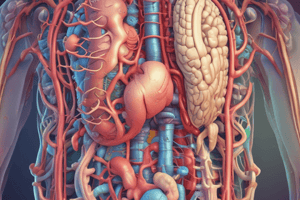Podcast
Questions and Answers
What is the main purpose of segmentation contractions in the small intestine?
What is the main purpose of segmentation contractions in the small intestine?
- To propel chyme through the small intestine
- To regulate the frequency of migrating motility complexes
- To prevent the return of fecal content into the small intestine
- To mix chyme with intestinal secretions and bring it into repeated contact with the intestinal absorptive epithelium (correct)
What regulates the intensity of segmentation contractions?
What regulates the intensity of segmentation contractions?
- Motilin and gastrin
- Sympathetic activity and slow waves
- Long and short reflexes only
- Parasympathetic activity and hormones (correct)
Where is the frequency of segmentation contractions highest?
Where is the frequency of segmentation contractions highest?
- In the ileum
- In the jejunum
- In the duodenum (correct)
- In the stomach
What type of movements are responsible for propelling chyme through the small intestine?
What type of movements are responsible for propelling chyme through the small intestine?
What prevents the return of fecal content into the small intestine?
What prevents the return of fecal content into the small intestine?
What type of contractions occur during the inter-digestive period?
What type of contractions occur during the inter-digestive period?
What is the approximate frequency of migrating motility complexes?
What is the approximate frequency of migrating motility complexes?
What is the function of migrating motility complexes?
What is the function of migrating motility complexes?
What is the main dietary source of carbohydrates?
What is the main dietary source of carbohydrates?
What is the process by which carbohydrates are broken down into their component monosaccharides?
What is the process by which carbohydrates are broken down into their component monosaccharides?
Where does the digestion of carbohydrates begin?
Where does the digestion of carbohydrates begin?
What is the enzyme responsible for breaking down starch into maltose, maltotriose, and limit dextrin?
What is the enzyme responsible for breaking down starch into maltose, maltotriose, and limit dextrin?
What is the pH at which pepsin is optimal?
What is the pH at which pepsin is optimal?
What is the form in which most dietary fat is found?
What is the form in which most dietary fat is found?
Where does protein digestion begin?
Where does protein digestion begin?
What is the result of pepsin breaking peptide bonds?
What is the result of pepsin breaking peptide bonds?
What is the main function of the peritoneal cavity?
What is the main function of the peritoneal cavity?
What is the primary function of gastrin and other GI hormones?
What is the primary function of gastrin and other GI hormones?
What is the effect of norepinephrine on the smooth muscle of the digestive tract?
What is the effect of norepinephrine on the smooth muscle of the digestive tract?
What is the primary function of the mesentery?
What is the primary function of the mesentery?
Which organs are considered retroperitoneal organs?
Which organs are considered retroperitoneal organs?
What is the result of a wound, perforating ulcer, or burst appendix in the peritoneum?
What is the result of a wound, perforating ulcer, or burst appendix in the peritoneum?
What is the percentage of cardiac output received by the splanchnic circulation?
What is the percentage of cardiac output received by the splanchnic circulation?
What is the function of the hepatic portal circulation?
What is the function of the hepatic portal circulation?
Which structural modification in the small intestine forces chyme to spiral slowly through the lumen?
Which structural modification in the small intestine forces chyme to spiral slowly through the lumen?
Which enzyme is responsible for breaking down lactose in the small intestine?
Which enzyme is responsible for breaking down lactose in the small intestine?
What type of cells are primarily responsible for mucus secretion in the villi of the small intestine?
What type of cells are primarily responsible for mucus secretion in the villi of the small intestine?
How are glucose and galactose primarily transported across the small intestine's epithelial cells?
How are glucose and galactose primarily transported across the small intestine's epithelial cells?
What is the main form in which carbohydrates are absorbed in the small intestine?
What is the main form in which carbohydrates are absorbed in the small intestine?
Which structural modification contains brush border enzymes that complete the digestion of carbohydrates and proteins?
Which structural modification contains brush border enzymes that complete the digestion of carbohydrates and proteins?
Which enzyme is involved in the breakdown of sucrose in the small intestine?
Which enzyme is involved in the breakdown of sucrose in the small intestine?
Which enzyme continues the digestion of carbohydrates in the small intestine and has an optimal pH of ~7?
Which enzyme continues the digestion of carbohydrates in the small intestine and has an optimal pH of ~7?
Which neurons send messages to the myenteric plexus?
Which neurons send messages to the myenteric plexus?
What is the result of impulses being sent distally in the enteric nervous system?
What is the result of impulses being sent distally in the enteric nervous system?
Which of the following is NOT a function of the colon?
Which of the following is NOT a function of the colon?
What types of contractions allow absorption through the large intestine’s epithelium?
What types of contractions allow absorption through the large intestine’s epithelium?
What facilitates mass movements in the colon?
What facilitates mass movements in the colon?
Which contraction type forms haustrations in the colon?
Which contraction type forms haustrations in the colon?
Which reflex initiates the defecation process?
Which reflex initiates the defecation process?
What is the only secretion of the esophagus?
What is the only secretion of the esophagus?
Flashcards are hidden until you start studying



